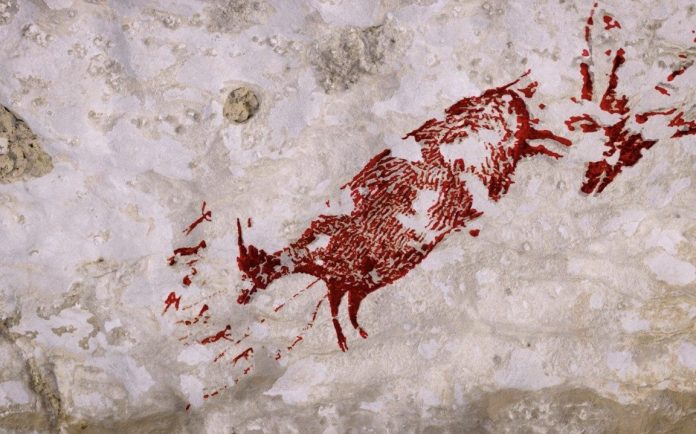A 44,000-year-old cave painting discovered in Indonesia is believed to be the earliest known hunting scene to be uncovered.
The image portrays a group of part-human, part-animal figures – therianthropes – hunting large mammals with spears or ropes.
The team of archaeologists, led by Griffith University in Australia, who made the find say it sheds new light on the origin of modern human cognition.
Published in the Nature journal, their paper describes the ancient painting in a limestone cave on Sulawesi as our oldest known rock art.
The figurative depiction of hunters as therianthropes may also be the oldest evidence for our ability to imagine the existence of supernatural beings.
Prehistoric cave art provides some of the most direct insight available into the earliest storytelling.
The Upper Palaeolithic cave art of Europe – around 21,000 to 14,000 years ago – encompasses the oldest images previously known of humans and animals interacting in recognisable scenes.
Professor Maxime Aubert, Associate Professor Adam Brumm and colleagues used Uranium-series analysis to date a 14ft 9in (4.5m) wide rock art panel as at least 44,000 years old.
The monochromal paintings appear to show human-like figures hunting six animals – two pigs and four dwarf buffaloes.
At least eight small human-like figures with spears or ropes appear with the animals.
According to the researchers, both the human-like figures and animals were painted at the same time, in the same artistic style, using the same technique and dark red pigment.
They also all show similar states of weathering.
The authors suggest the inclusion of therianthropes may indicate that Indonesian cave art involved religious-like thinking about the human-animal connection long before humans first made art in Europe.
The researchers were led by Griffith archaeologists Prof Aubert, from the Griffith Centre for Social and Cultural Research (GCSCR) and the Australian Research Centre for Human Evolution (Arche), and Associate Prof Brumm, from Arche.
Prof Aubert said: “The cave painting from Leang Bulu’ Sipong 4 suggests that there was no gradual evolution of Palaeolithic art from simple to complex around 35,000 years ago – at least not in Southeast Asia.
“All of the major components of a highly advanced artistic culture were present in Sulawesi by 44,000 years ago, including figurative art, scenes, and therianthropes.”
Associate Prof Brumm said: “The images of therianthropes at Leang Bulu’ Sipong 4 may also represent the earliest evidence for our capacity to conceive of things that do not exist in the natural world, a basic concept that underpins modern religion.”













